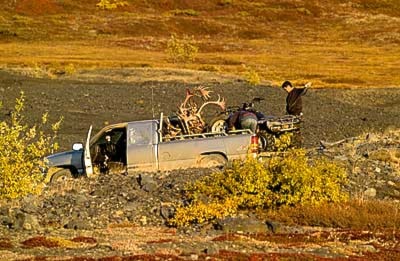The scenery of the Dempster Highway is known for inspiring awe, not nausea.
But what two Yukon men witnessed on the road this week made them feel ill.
They saw as many as eight trucks of hunters from the Northwest Territories using high-frequency radios, all-terrain vehicles and other high-tech gear to shoot members of the fragile Porcupine caribou herd near the highway between Eagle Plains and the NWT border.
The witnesses describe the operation as an industrial-style slaughter. They drove the road to see caribou and they found nothing but carcasses.
“I was just really disgusted,” said one man. “I don’t think it’s right. If this continues year after year, we won’t have any caribou left,”
“I was almost in tears. You know when something is wrong, when it is not right?”
Both men requested anonymity, citing fear for their personal safety.
“The last thing I need is somebody to smash or threaten me or something,” one said.
News of such hunting practices was condemned by Joe Linklater, chief of Vuntut Gwitchin First Nation. His constituents in Old Crow depend on the caribou for food.
He says hunting caribou by ATV near the Dempster is “ridiculous.”
“That’s just not respectful for the herd, or the people who depend on it for food.”
What’s more, the current health of the herd is unclear, says Linklater.
For several years, aerial counts of the Porcupine herd have been thwarted by bad weather.
The last count, in 2001, found 123,000 caribou. But researchers believe the actual number now sits at around 115,000.
That’s a significant decline from 1989, when 178,000 caribou were seen.
Until more is known about the herd’s health, Old Crow residents have volunteered to limit the number of caribou they take to “bare minimum” for subsistence, Linklater said.
Meanwhile, Linklater worries “these guys are just making the situation worse.”
But, the hunters on the Dempster are playing by the rules, according to present laws.
Tetlit Gwitch’in of the Northwest Territories are entitled to hunt along the Dempster, thanks to a land-claim deal struck in July 1991.
Land-claim rights trump territorial hunting regulations. That’s why a no-hunting corridor, extending 500 metres from the Dempster, was abandoned by the Yukon government last autumn.
So, when conservation officers watched NWT natives hunt on the Dempster this week, there were few rules to uphold.
There is no limit on how many caribou aboriginal hunters can shoot. Nor are there rules restricting the use of ATVs or any other technology.
“Sometimes it looks a bit ugly up there, but there’s not much we can do, other than just ensure that’s nothing’s wasted,” said Torrie Hunter, who manages the conservation officers who monitor northern Yukon.
There are not many caribou presently near the Dempster, said Hunter. Most migrate across the highway in October.
But, the two concerned men who reported the carnage are worried what they saw was simply a warm-up for a bigger slaughter to come.
Conservation officers will be watching the highway during the migration, said Hunter. But “we’re fairly limited by what we can do, enforcement-wise.”
His location doesn’t help. He’s based in Dawson City.
“It’s 400 kilometres north of here, so it’s not like I can jump in a truck and go up there for an afternoon. It’s remote. And there are only two officers here.”
A management plan that may set rules on native hunting of the Porcupine herd is currently being developed by the Porcupine Caribou Management Board.
But, as it stands the board can only urge that hunters restrain themselves by only taking bulls, and by taking fewer animals than usual.
One of the witnesses said he believed that he saw cows being shot.
A report issued by the board in July warns that “harvesting like normal could make the population of the herd go down further and faster so that it would take many, many years to recover.”
Gwitch’in from both the Yukon and NWT are involved in the creation of the management plan.
It’s not clear in which community the NWT hunters live.
The concerned men suspected Fort McPherson — the community closest to the Yukon border.
But, in Fort McPherson, Chief Wilbert Firth said the hunters he represents abide by their own voluntary restrictions.
No hunting of caribou by ATV is permitted, he said, and hunters may only take one caribou per family.
He said he suspected the hunters came from farther away.
There are two other NWT communities connected to the Dempster: Tsiigehtchic and Inuvik.
Regardless of where the hunters came from, Linklater says that he believes the NWT and Yukon governments should do more to restrict hunting.
“We have to reconsider the 500-metre corridor along the Dempster Highway, and try to find some way to instil proper hunting practices for that herd,” said Linklater.
The Dempster corridor is still on the books, he said.
“The Yukon government isn’t enforcing that law right now, but they could.
“The Yukon government can impose a ban on hunting if they have a conservation concern,” he added.
Reviving the Dempster no-hunt corridor may not do much good, the two concerned men say.
The hunt they saw was beyond that limit — but so well co-ordinated, one worries few caribou can escape.
“It’s like dragging the ocean bottom,” he said.
Whether the hunt is legal or not is beside the point, the man said.
“It is evil,” he said. “It is immoral. It is not about legality.
“When legality is about wiping out your herd, what do you do?”
